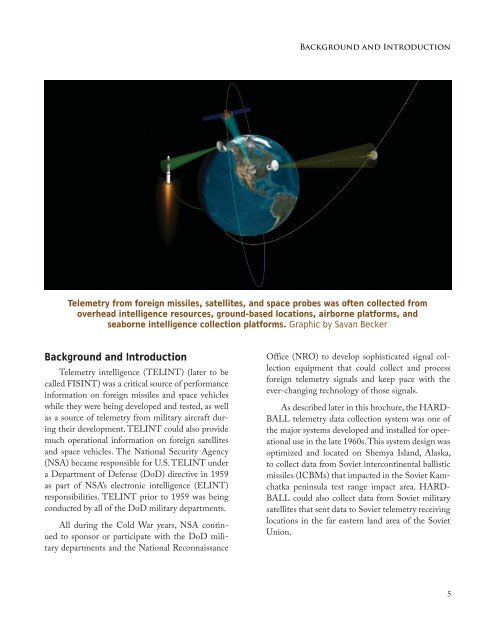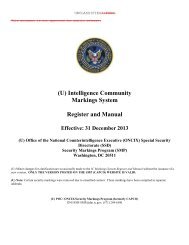Telemetry Intelligence (TELINT) During the Cold War
telint-9-19-2016
telint-9-19-2016
You also want an ePaper? Increase the reach of your titles
YUMPU automatically turns print PDFs into web optimized ePapers that Google loves.
Background and Introduction<br />
<strong>Telemetry</strong> from foreign missiles, satellites, and space probes was often collected from<br />
overhead intelligence resources, ground-based locations, airborne platforms, and<br />
seaborne intelligence collection platforms. Graphic by Savan Becker<br />
Background and Introduction<br />
<strong>Telemetry</strong> intelligence (<strong>TELINT</strong>) (later to be<br />
called FISINT) was a critical source of performance<br />
information on foreign missiles and space vehicles<br />
while <strong>the</strong>y were being developed and tested, as well<br />
as a source of telemetry from military aircraft during<br />
<strong>the</strong>ir development. <strong>TELINT</strong> could also provide<br />
much operational information on foreign satellites<br />
and space vehicles. The National Security Agency<br />
(NSA) became responsible for U.S. <strong>TELINT</strong> under<br />
a Department of Defense (DoD) directive in 1959<br />
as part of NSA’s electronic intelligence (ELINT)<br />
responsibilities. <strong>TELINT</strong> prior to 1959 was being<br />
conducted by all of <strong>the</strong> DoD military departments.<br />
All during <strong>the</strong> <strong>Cold</strong> <strong>War</strong> years, NSA continued<br />
to sponsor or participate with <strong>the</strong> DoD military<br />
departments and <strong>the</strong> National Reconnaissance<br />
Office (NRO) to develop sophisticated signal collection<br />
equipment that could collect and process<br />
foreign telemetry signals and keep pace with <strong>the</strong><br />
ever-changing technology of those signals.<br />
As described later in this brochure, <strong>the</strong> HARD-<br />
BALL telemetry data collection system was one of<br />
<strong>the</strong> major systems developed and installed for operational<br />
use in <strong>the</strong> late 1960s. This system design was<br />
optimized and located on Shemya Island, Alaska,<br />
to collect data from Soviet intercontinental ballistic<br />
missiles (ICBMs) that impacted in <strong>the</strong> Soviet Kamchatka<br />
peninsula test range impact area. HARD-<br />
BALL could also collect data from Soviet military<br />
satellites that sent data to Soviet telemetry receiving<br />
locations in <strong>the</strong> far eastern land area of <strong>the</strong> Soviet<br />
Union.<br />
5








